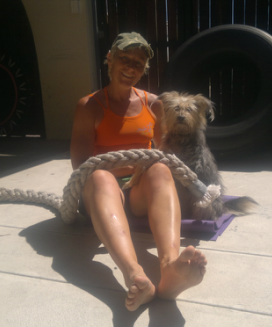* Managing the behaviour - Preventing the dog from being put in a position where the behaviour occurs. Preventing a behaviour through managing the environment can be very practical. It can often be less time consuming than modifying behaviour, though still requires planning and diligence. An example is a dog who jumps on visitors being prevented from practising this behaviour by:
a) putting the dog behind a barrier when visitors arrive e.g. a temporary child gate, or
b) placing the dog in another room or outside when visitors come, or
c) tethering the dog inside or keeping the dog on a lead with visitors.
* Ignoring the behaviour - This can be effective if the behaviour isn't a huge problem or a safety issue. It does not work effectively with well learned and practised behaviours, those that are self-reinforcing (think barking or toileting) or behaviours associated with fear or anxiety. Using the same example as above, it would mean letting the dog jump up on visitors, hoping that in the end your dog may eventually "grow out" of the behaviour. If your dog is being reinforced in some way by jumping up on visitors (eye contact, verbal or physical contact), you could be waiting forever! I prefer not to use this method in isolation. Giving an alternative behaviour as well as removing reinforcement for the problem behaviour is generally more efficient and less frustrating for both the dog and guardian.
* Changing the Behaviour - This can be done a number of ways. A very effective method is to provide an alternative behaviour for the dog to do instead of the problem behaviour. Ensure the problem behaviour no longer receives reinforcement whilst at the same time making sure the replacement behaviour really pays off big time. For the jumping example, teaching your dog to;
* sit when greeting, or
* keep all four feet on the floor, or
* go to their bed
when visitors arrive works a treat.
The example below shows Zuri in the process of being taught not to jump when greeting visitors.
Which method is best for which situation? Each situation and problem will vary, since each dog and each family varies greatly. Each choice will be based on a multitude of individual factors. One choice I personally find a no-brainer is the avoidance of punishment as a way of changing behaviour. Why? It seldom works. If it does appear to work, it is actually masking its real achievement: suppressing behaviour NOT changing it. The underlying motivation behind the behaviour is seldom addressed with punishment. Further, the side effects of punishment are numerous and unpleasant for the subject (that is its modus operandi). When there are effective alternatives, choosing punishment is also unethical.
The decision to modify a behaviour will depend on;
* how important changing behaviour is to the individual and circumstances,
* whether management and prevention is a feasible option,
* whether there is a commitment to training through to its fruition and maintenance, and
* whether the subject with the problem behaviour is a realistic candidate for change.
This is where a professional consultant can help with guidance on what is feasible and what may be in the too-hard-basket. Some things will require more effort and time than a guardian can commit. Some things may be unsafe. Some behaviours will have such a strong history or genetic component making them resistant to behaviour change.

The behaviour could have easily been prevented by keeping Dancer inside. Being out of earshot and sight of the stimulus that caused the reaction would have prevented the behaviour.
The decision to proceed with a behaviour change plan was made because:
* the guardian had a strong desire to keep her dog with her when she worked out,
* the guardian had a commitment to diligently work on re-training and enjoyed training,
* Dancer already possessed a well trained behaviour that could be used as the replacement behaviour - this would make training quicker,
* Dancer had a solid history of training using positive reinforcement,
* Dancer was a quick and eager learner, and
* she was extremely food motivated - which all worked in her favour to over-ride her desire to attack the rope.
I think a most satisfactory choice was made for this particular situation :-)

 RSS Feed
RSS Feed